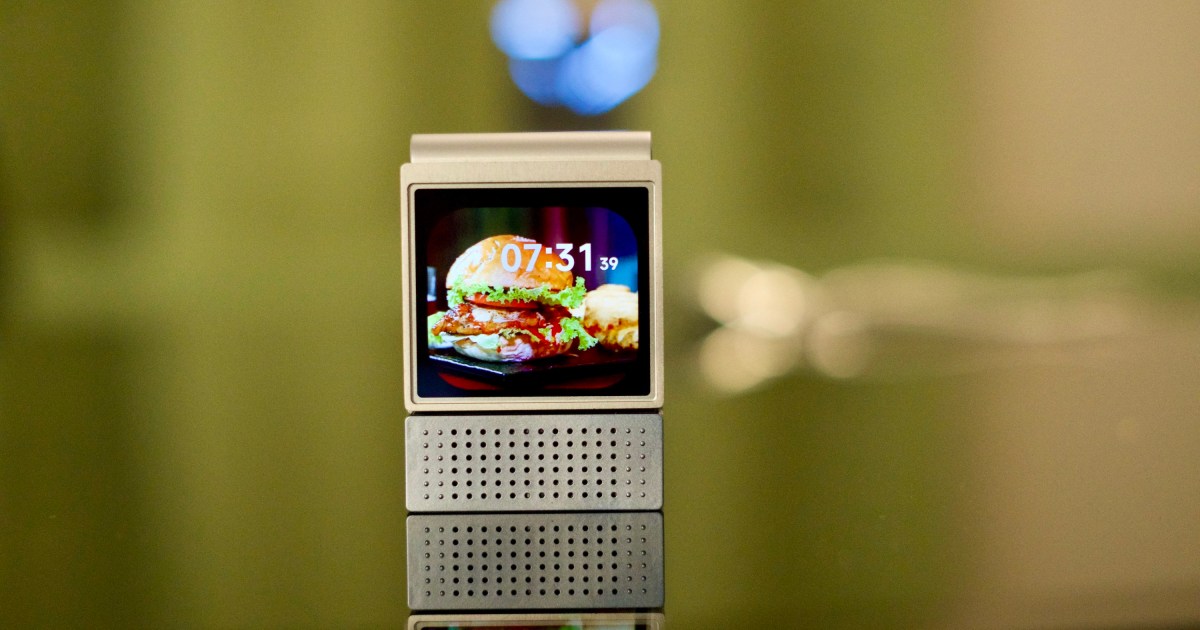What’s the next big thing in health gadgets? Smartwatches and fitness bands are everywhere. Smart rings had their breakout year in 2024 and are expected to have another in 2025. Smart scales are the norm, and high-tech ways to check your blood pressure are also commonplace. What comes next?
At CES 2025, I had the opportunity to see what it was all about. In a closed-door demo session, Amazfit showed me the new Amazfit V1tal, a small device that records you while you eat so it can automatically record your food and provide nutritional information. It’s a bit of a crazy concept, but after seeing the gadget for myself and hearing Amazfit’s talk, I think it could be huge.
What exactly is the Amazfit V1tal?
The Amazfit V1tal is unlike any other health gadget I’ve seen before. When you sit down to eat, you press a button on the V1tal to open the top, with the motors automatically moving the screen away from you and revealing the camera. You place the V1tal on the table, make sure the camera has a view of your plate, press the record button, then eat as usual. When you’ve finished your meal, stop recording on the V1tal, that’s it.
What happens next is the fun part. The V1tal takes the recording of your meal, analyzes it and sends it to Amazfit’s Zepp app (the same one used to control Amazfit watches like the Amazfit active 2). Once there, it’s recorded in the app as the meal you ate that day, including a breakdown of calorie counts and macro values, including carbs, protein and fat. It’s similar to logging food with an app like MyFitnessPal or Lifesum, but instead of having to scan barcodes or manually enter all the ingredients of a meal you ate, the V1tal gets all this information from the recording.
What is particularly interesting is that V1tal is also interested in your eating behavior. For example, it will see if you sat down with a burger and salad but barely touched your greens. It will also detect if you are rushing through your meal and eating too quickly. When it sees these items, it lets you know, alongside the recorded meal, with information and advice on how to improve in the future.

Logging and tracking food is nothing new; Many mobile apps have offered this functionality for years. And while these apps can be very useful, remembering to manually record everything you ate is a tedious and easily forgettable task. The Amazfit V1tal should solve this problem. Put it on the table, eat your meal, stop recording, and just like that, you’ve recorded your meal.
The other interesting part is how the V1tal will ultimately tie into the rest of the Amazfit ecosystem. Amazfit has plenty of smartwatches and fitness trackers in its portfolio, and it’s easy to imagine how the V1tal could be another useful puzzle piece.
In speaking with Scott Shepley (Head of Global Marketing for Amazfit) and Jonathan Johnson (Head of North American Marketing for Amazfit), they gave the example of someone training for a marathon. You can get your activity and sleep data from an Amazfit watch and your nutritional data from the V1tal, and Amazfit could use both pools to offer better workout or nutritional information.
Amazfit wants the V1tal to do more

Where things get even more interesting (and a little worrying) is how Amazfit wants the V1tal to go beyond recording and logging food. The V1tal runs Amazfit’s Zepp operating system – the same software on its smartwatches – and that means you get smartwatch-like functionality. The V1tal can display your phone’s notifications, set timers, manage a to-do list, and much more. You can also use the camera for regular video recording if you want.
At one point, Shepley and Johnson referred to the Humane AI Pin and the Rabbit R1 and how they want the Amazfit V1tal to be a better version of it. The main purpose of the V1tal right now is to track and log your food, but Amazfit has big ambitions for the V1tal to be much more than that. One example given was having the V1tal on your desktop and using your voice to ask it to open Amazon and buy something for you.
It was encouraging to hear Shepley and Johnson talk about these big visions for V1tal, but this is also where it got me thinking. To me, the pitch for a dedicated health device to help you record your meals and improve your diet is unique and interesting. In comparison, I’d stay away from another all-in-one AI gadget that rivals two of the biggest tech mistakes of 2024.
I voiced these concerns to Shepley and Johnson, who both seemed to understand the balance before them: providing a device with focused intent while also offering additional features to people who want them. As long as the V1tal focuses on being a nutritional device first and offering additional features second, I think it will be fine. We’ll just have to see if that’s what actually happens.
A glimpse into the future of health gadgets

Fortunately, you shouldn’t have to wait long for this. Although it is only a prototype for now, Amazfit plans to launch the V1tal in the first or second quarter of this year. Unlike many concept and prototype announcements at CES, you will be able to buy and use the V1tal in the very near future.
I’m sure there will be some apprehension at the idea of a device monitoring you while you eat. Still, it’s easy to see that this is an incredibly useful gadget for so many people, whether you’re trying to lose weight, gain weight, track your macros, or get better insight into your eating behavior. The Amazfit V1tal could be instrumental in all of these scenarios, and it’s blazing a new trail in health gadgets like we’ve never seen before.
Amazfit’s pitch for V1tal is impressive. The next step is to see how it performs in the real world and if it can deliver what Amazfit promises – and I certainly hope it does.






